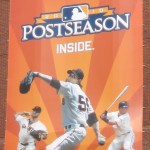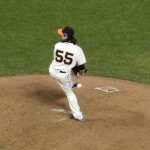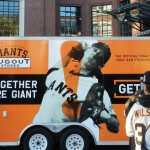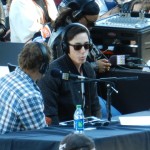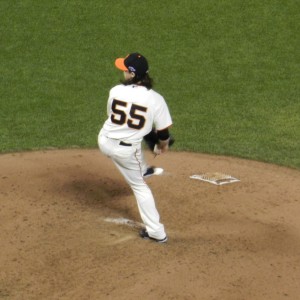
Consequently, it seemed likely that Tim Lincecum would also wear a different uniform in 2014. After ERAs of 5.18 and 4.37 the last two seasons, the Giants would not offer him the same $22.5 million that he received in 2013. Instead, they would tender the $14 million necessary to receive compensation if he departed as a free agent. Lincecum would politely decline the pay cut and join one of the many other teams in Major League Baseball with cash to burn and never enough starting pitching. That was the conventional wisdom, anyway. Naturally, the Giants and Lincecum decided to throw everyone a change-up. Not only did the Giants offer $17.5 million annually for two years, but Lincecum took it, and the deal was surprisingly fast.
Most of the media reaction has been negative. An ESPN article titled “Giants Pay Lincecum For Past Glory” is typical of the general belief that the Giants signed Lincecum out of wishful thinking, retaining a popular player but refusing to acknowledge that his best years are behind him. Baseball analysts point out that Lincecum has lost speed on his fast ball, averaging about 91 mph in 2013 compared to 95 mph in 2008. Moreover, he has also had problems with control, walking more hitters and, conversely, offering too many good pitches to hit when he gets behind in the count early in games. Given his famously delicate pitching motion and the extraordinary athletic conditioning required to maintain it, analysts have come to regard his two-year decline as evidence that his license to defy the laws of physics may be ready to expire.
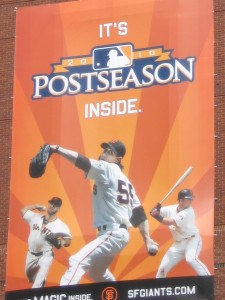
Where the Giants deserve criticism is their obvious lack of alternatives for Lincecum’s spot in the rotation if they had been more inclined to doubt his prospects for 2014. Analysts point to the Giants’ 2011 trade of their top pitching prospect, Zach Wheeler, to the Mets for two months’ worth of Carlos Beltran’s services as a primary cause of the Giants’ current lack of capable starting pitching in their farm system. Despite the Giants’ failure to make the playoffs in 2011 or to keep Beltran in 2012, as well as Wheeler’s relative success with the Mets, the trade was still a good move to make. In July 2011, the Giants were first place on the basis of their starting pitching, which had picked up where it had left off in 2010, but their lineup had totally collapsed due to Buster Posey’s injury and a number of post-championship hangovers among his healthy teammates, particularly Aubrey Huff. When a team has won its first title in a half-century and has a reasonable chance to defend it the following year, its general manager has a moral obligation to fans to try to make that happen. Giants GM Brian Sabean understood this and said so when he announced the trade. More telling, however, was his additional comment that it was up to him and his scouting staff to find or develop more Zach Wheelers to stock future Giants rotations. Up to now, that has not happened, and the Giants farm system’s current ranking of 20th out of 30 teams according to Baseball America is an unfortunate indictment of their performance and suggests no relief from that quarter anytime soon.
It therefore seems strange that the Giants, who were willing to spend $35 million to keep Lincecum with his uncertain prospects, decided not to spend $6.5 million to exercise Ryan Vogelsong’s option for 2014. While Vogelsong’s 5.73 ERA and 4-6 record in 2013 was a precipitous drop from his dominance in the 2012 playoffs and Series, his problems came mostly from a short offseason made all the more so by his participation in the 2013 World Baseball Classic. Nor did it help him to break his hand in May on a bunt attempt. The Giants are right to be concerned about his fast ball, which declined below 90 mph by the end of the season (edging into Barry Zito territory), but $6.5 million is a small amount to wager, at least in the current fiscal environment of baseball, that a full offseason would allow Vogelsong to recover and regain his 2012 form. The Giants’ assistant GM Bobby Evans suggested that the Giants declined the option mostly to reserve their finite 2014 budget for other free agent acquisitions, such as former Atlanta and Oakland pitcher Tim Hudson, whom the Giants recently signed at a relatively affordable $23 million over two years. If the Giants truly chose to pinch pennies over Vogelsong, their decision sounds disturbingly like the one they made in 2003 to trade Russ Ortiz, the #2 starting pitcher in their 2002 World Series rotation, to the Atlanta Braves for a bag of balls named Damian Moss. That was also a fiscal decision, and Ortiz won 21 games for the Braves that year while Moss was gone from the Giants’ roster by mid-season. If Ortiz had remained with the Giants, it is easy to believe that they might have slipped by the Florida Marlins in the 2003 playoffs (Ortiz’s eventual replacement, Sidney Ponson, blew his start in that series) and possibly shortened the wait for their first world championship in San Francisco by seven years. Even with Hudson joining the Giants, they will still need another pitcher to complete their rotation, and while the recent drunken-sailor spending by the Dodgers is not an ideal model for managing a franchise, there is such a thing as being penny-wise and pound-foolish in baseball.

For now, it is a pleasure to know that Lincecum will remain with us for a while. He is still Timmy, which is the proper form of address for someone who at twenty-nine still looks barely old enough to shave and seems to belong more on a skateboard than a pitching mound. Despite his occasional failure to avoid profanity in front of the camera, he remains a much more congenial face of the franchise that his predecessor, Barry Bonds, from whom he also inherited the coveted locker in the southwest corner of the Giants’ clubhouse. Even if you’re not a Giants fan, you can’t help but want him to succeed, and he shows as much as anyone that baseball, despite Jerry Seinfeld’s famous quote, is more than just rooting for laundry.

